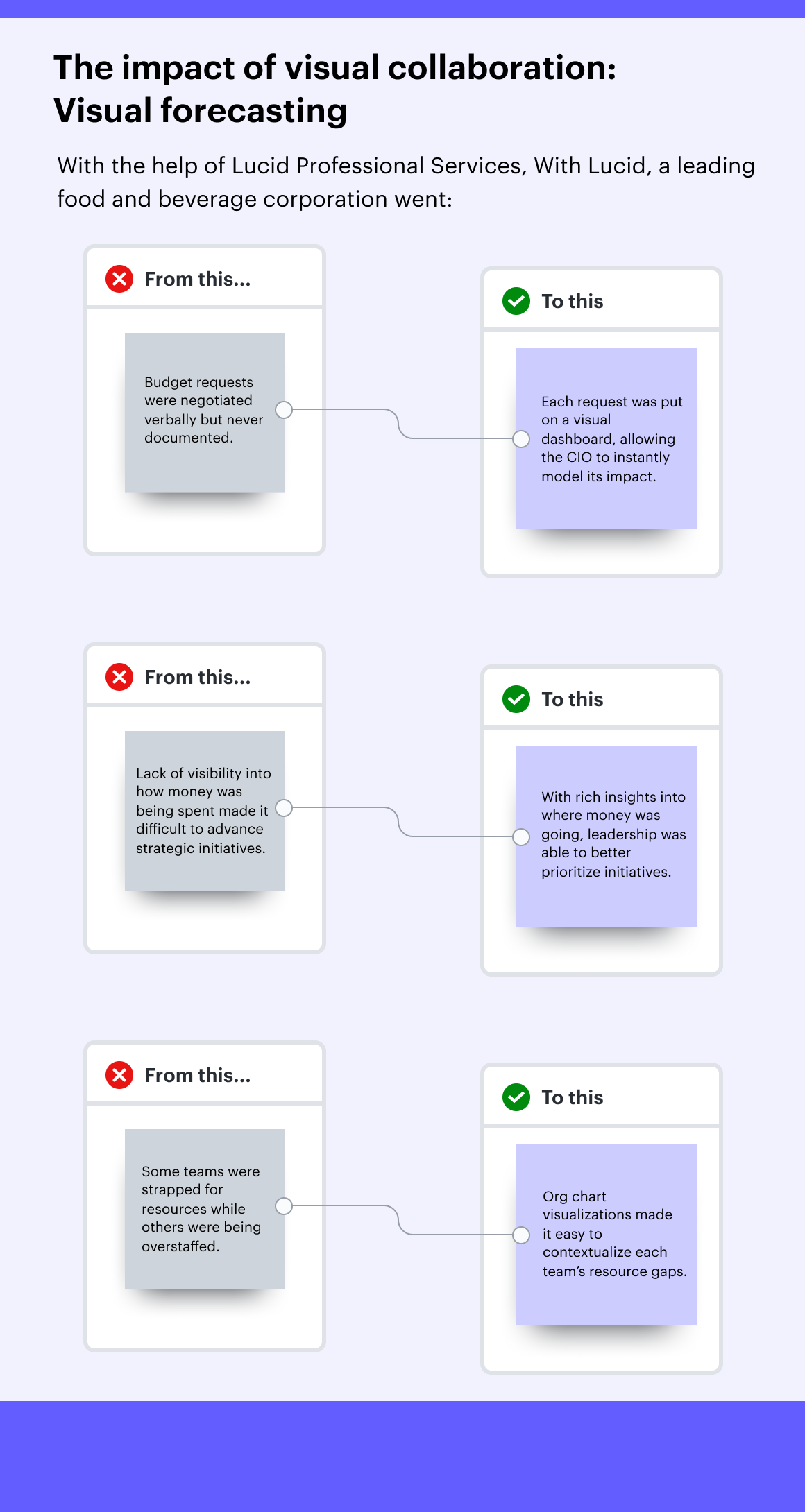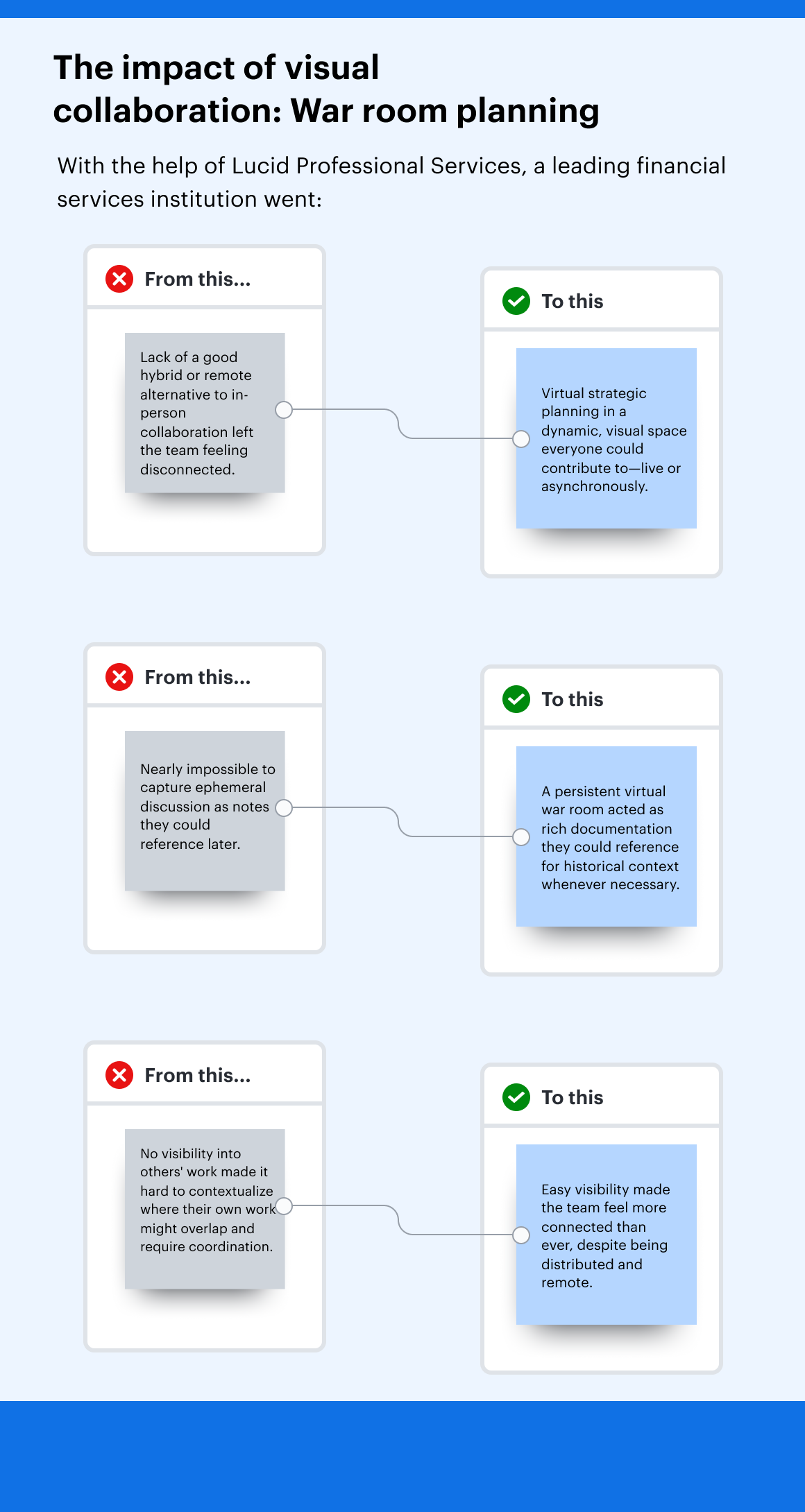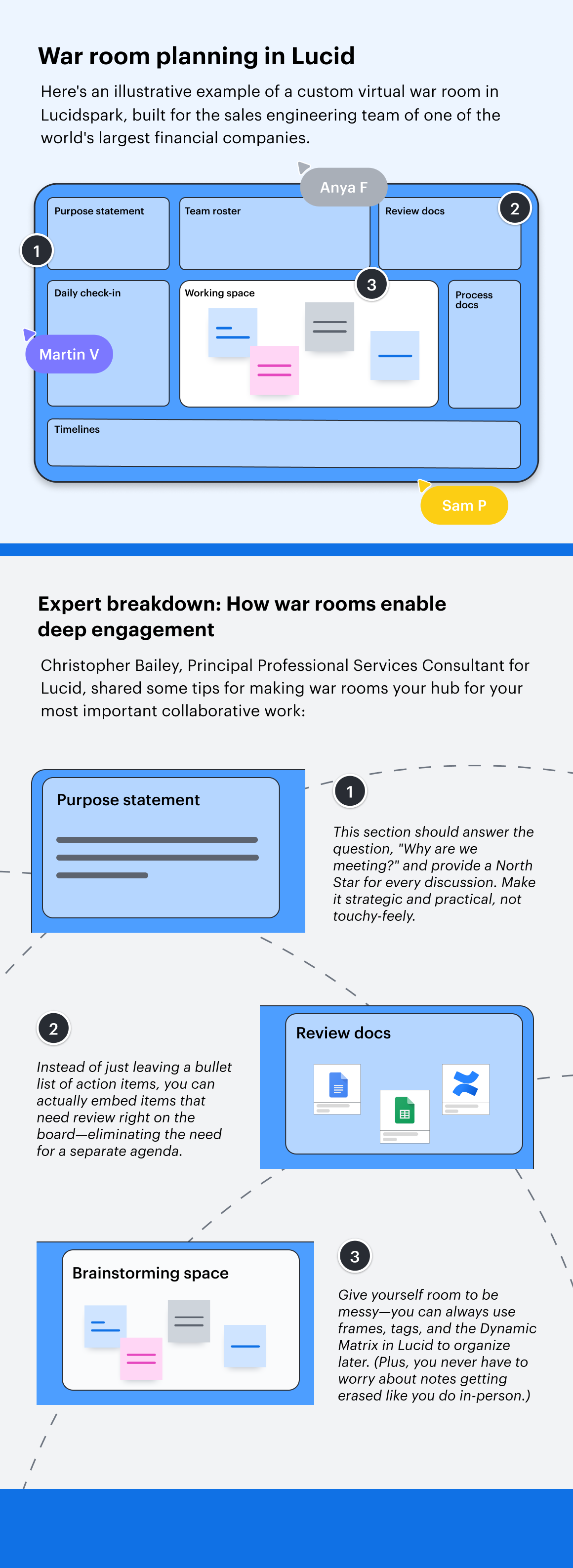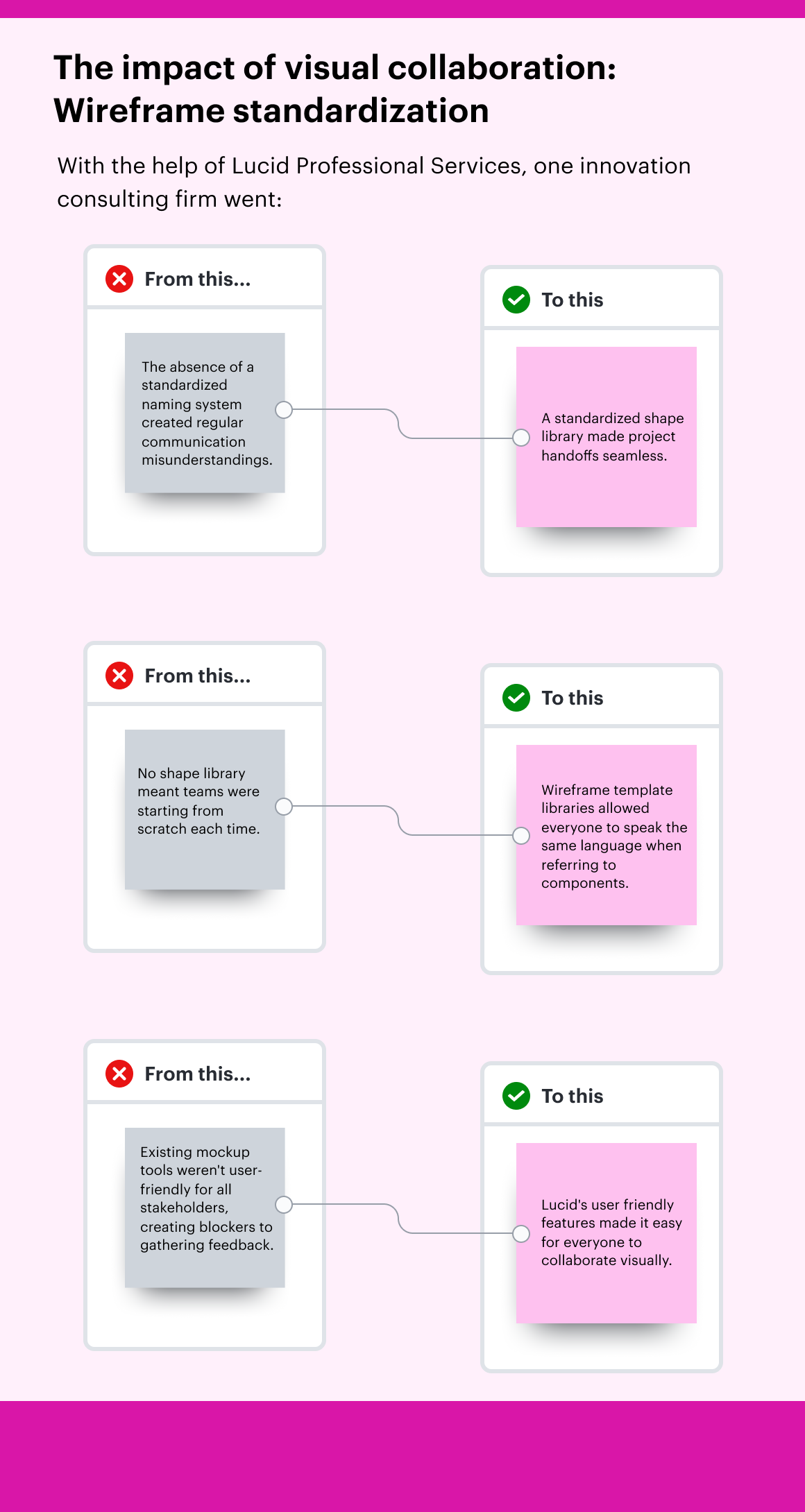
Lucid in action: Paving a clear path to organizational transparency with Lucid professional services
Reading time: about 14 min
This is the first in a multi-part series exploring how companies are keeping ahead of the curve by partnering with Lucid’s professional services team to adopt innovative ways to work within the Lucid Visual Collaboration Suite. If you’d like assistance adopting similar strategies, frameworks, and techniques within your organization, make sure to contact Lucid’s professional services team.
If we assume most companies genuinely want to empower their teams to do self-managed, collaborative, innovative work, it’s hard to justify poor transparency as a good business decision.
Professionals have made their stance on the issue clear. A survey from The Org found that 73% of employees felt their work life would improve with more transparency, with 84% of millennials saying they would be more loyal to a transparent company.
The bar isn’t particularly high, either: Half of employees have never even seen their company’s org chart. (Yikes.)
With the exception of legitimate proprietary and confidential information, most companies don’t set out with the intention to be opaque and throw roadblocks in the way of their employees. But it often happens anyway.
What do we mean when we say transparency?
For the purposes of this piece when we use the term “transparency,” we aren’t referring to external transparency—the policies and practices by which companies share information with customers, potential hires, investors, and the public.
We are referring to internal, organizational transparency—that is, the systems companies implement that allow employees to communicate openly about everything, access all the information and context they need to do their job effectively, and make data-backed decisions.
What causes companies to not be transparent?
The biggest enemy of transparency is “This is just the way we’ve always done it.” Many companies may also just not realize the importance of transparency efforts like documentation and open communication until problems start to arise—like a lack of collaboration or employees moving on to other companies.
There are a handful of possible reasons that companies may not be as transparent as they’d like to be. Here are just a few:
- Lack of upkeep: Documentation is a time-intensive part of building transparency, and yet it often gets treated like the dirty job that no one wants to do, rather than an integral part of maintaining a record of innovation within your business. Without active maintenance of your documentation (which doesn’t actually need to be hard), critical information will become outdated and fall into disarray over time.
- A culture of hoarding: Imagine ten panes of glass stacked on top of each other, each one providing a view through it to the one below it. Now imagine one of the panes toward the top of the stack is painted jet black, blocking the view of anything below or above it. It only takes one unwilling, withholding team to not be on board to cause transparency issues for an entire organization. In some companies, people pride themselves in their ability to answer questions, and see documentation as a hit to their perceived value.
- Org design: Many silos form as a byproduct of the way you structure your teams. If colleagues aren’t incentivized or allowed to collaborate cross-functionally, they may create their own workarounds for getting their job done when they feel blocked, instead of building systems for documenting and resolving common issues at the org level. When teams rely on their own “hacks” instead of seeking alignment with other teams, it prevents you from building shared knowledge.
- Lack of standardization: Transparency isn’t just about what you can access, but the speed of knowledge acquisition. Even if your data is technically accessible, your repository might be too complex to navigate, or information might be displayed in a way that’s confusing or esoteric.
- Tooling: If your tech stack is stuffed with too many tools, it’s impossible to centralize and standardize knowledge, especially if the tools in the stack don’t integrate well. And a surprising number of companies don’t use any kind of collaboration-focused software at all, relying on the ticking time bomb of institutional knowledge instead of a system of visual, visible knowledge repositories.
These issues aren’t impossible to solve, but according to Christopher Bailey, principal professional services consultant at Lucid, tackling transparency requires you to first start with an honest conversation about the work required to make a change.
“In many cases it comes down to power,” said Bailey. “Some people feel the only way to move up in an organization is by knowing things others don’t. It’s a problem we see often with clients as we work to help them adopt better documentation practices.”
How Lucid makes transparency effortless and communication easy
At its core, transparency is an inherently visual concept: “Transparency” draws its origins from a Latin word meaning “to show through.”
Yet when it comes to building systems that promote transparency, it’s shocking how few companies incorporate visuals at all.
If your approach to transparency is still a messy word document, a bloated Slack channel, a spreadsheet that hasn’t been updated in three years, or an old email thread that you just need a few minutes to track down: There are better ways to work. We promise.
Here’s how Lucid has helped three companies turn transparency into a reality with visual clarity-and unlock massive efficiencies in the way they communicate, plan, build, and report.
Meet the expert
As a member of Lucid’s professional services team, Christopher Bailey works with some of the largest companies in the world to solve complex hybrid work challenges—including transparency—through innovation coaching, process enhancements, and customized templates in the Lucid Visual Collaboration Suite.
Read on for insights and expert tips from Bailey that have helped companies unlock massive efficiencies in the way they communicate, plan, build, and report.

Schedule a consultation with Lucid’s professional services team now, and get transparency, communication, and documentation solutions tailor-fit to your organization.
Sign me upVisual forecasting: Making strategic decisions without the guesswork
When the CIO of a major global food and beverage company came to Lucid for assistance, his transparency issues were front and center:
- With no formal means of documenting funding requests for new headcount, he struggled to know what funds were available when competing requests came in from different teams.
- Because the finance team had no visibility into verbal commitments or earmarks the CIO had made previously, they frequently went over budget, or overstaffed certain projects while understaffing others.
- This lack of visibility into mission-critical hires meant the CIO was left to rely more on his best judgment call instead of rigorous strategic decision-making based on information around real-time needs and any potential high-priority break-in requests.
“These day-to-day problems are certainly difficult to navigate,” said Bailey. “But then you take another step back and see how this simple lack of transparency means you are in a defensive stance rather than a proactive one.”
“Your competitors might be capturing market share right in front of you, and it’s frustrating—because there’s nothing you can do to move faster without the ability to visually understand the challenges and opportunities in front of you and adapt to them. This is why visual collaboration tools are vital.”

The company’s IT organization was also in the process of switching from a project-based funding model to a product-based funding model—requiring project and headcount planning processes to be more closely integrated.
“This required them to switch the way they did headcount planning, from yearly to more responsive based on project needs,” said Bailey. “Both of those functions previously existed in silos with their own set of complexity and considerations, so they needed to be brought together thoughtfully.”
With Lucid’s help, this large food and beverage company was able to switch from keeping track of decisions informally—often just from memory or in a document somewhere—to implementing custom, full-fledged intelligent workflows for managing IT products, staffing decisions, and more. These workflows included forecasting dashboards so each team could have transparency into how decisions were being made.
The results?
- With these visual forecasting dashboards, the team was able to do scenario planning and “play around” with data on the same board—with graph designs linked to formulas that let them immediately see the key results of potential decisions.
- This company was immediately able to visualize where they were over- and under-hiring and made less costly mistakes.
- They also uncovered new opportunities to accelerate high-priority products because they found room in their budget they previously didn’t know they had simply because they never documented it.
Here’s what one piece of that workflow looked like:

Expert tips for implementing visual forecasting
Here are some of his other tips for getting your team aligned through visual forecasting:
- Start from a template: While the above is an example of a complexed, involved, bespoke solution for one client, you can actually bring intelligence and transparency to your own visual forecasting simply by starting from one of Lucid’s off-the-shelf templates—like these ones for planning organizational structures, personnel needs, and more. Standardizing on a template allows your team to consume necessary information faster.
- Give everyone access to the data they need: “You need to strike a balance between making sure that everyone can see the data that they need, while protecting information that you don't want people to have access to,” said Bailey. “Design your Lucidchart workflows with the data consumer in mind—right up to the CIO—so it’s a fully customized experience for each, but without the sense of ‘Oh, important information is being withheld from me.’”
- Be mindful about information you lock down: “We often see this aggressive need to lock all the things down, and I think we just have to reconsider that,” said Bailey. “Protecting sensitive information is one thing, but if you’re avoiding being transparent out of fear, your business likely has larger problems you need to address.”
War rooms: Bringing the best parts of human problem-solving to virtual spaces
When one of the largest financial institutions in the world was looking to equip its sales technology team with a collaborative space to develop new sales solutions, they reached out to Lucid to help them recreate their beloved war room experience virtually in Lucidspark. COVID-19 has forced them out of the office and out of their traditional “war room” setup (full of sticky notes, whiteboard markers, and paper Kanban boards).
The challenge? Because war rooms were so highly engaging and full of human interaction in-person, this company didn’t just want something that was a pale imitation of the “real thing”—they wanted something just as good.
“Some teams live and breathe in their war room,” said Bailey. “When you have a lot of decisions to make—and need to collaborate quickly and closely to remove blockers fast, with all the equipment and people you need at your fingertips, and big visuals printed out and pasted to the walls—it’s an effective way to work.”
But, as Bailey pointed out, there are a few disadvantages to in-person war rooms that virtual ones solve for:
- Unless you have the room booked for months at a time, it can be difficult to maintain an accurate record of everything that has been discussed during war room sessions. Despite best efforts, things will get erased, or serendipitous conversations will be forgotten. With virtual rooms, you can more easily “document as you go” without interrupting the flow of conversation and deliberation.
- If you need to bring any documentation into your war room session, there’s no easy way to make sure you are operating from the most up-to-date version of your information without creating new versions to tape up each day (or multiple times per day). A virtual canvas in Lucid is constantly updated.
- War rooms will inherently be dominated by verbal discussion, but often other means of engagement might be a better fit—like taking a quick vote or getting a temperature check on a given direction being considered. Lucid tools make it easier to launch into non-verbal means of collecting input and gathering dissent that can actually open you up to richer insights.
Even as some companies initiate hybrid or return-to-office policies, virtual war rooms persist as an effective form of collaboration because of these problems they solve compared to the physical version.

For this client, the new war room experience was a hit.
After working with Lucid to build out a custom war room, “they remarked just how much more human it made the experience of collaboration as a team again,” said Bailey. “They really felt like a team, instead of just individuals working adjacently.”
“They were very used to the physical space, and they wanted that again,” said Bailey. “War rooms make it really easy to get access to the things you need in the moment you need them, because you can just literally ask the person next to you.”
Here’s an example of what that looked like:

Expert advice for creating successful virtual war rooms
- Consider what you need to be successful, then bake it into your board: Taking the “kitchen sink” approach of dumping every possible document and data point you can find into your war room won’t make it more effective, Bailey said. “Rather, link your few most important resources and data points, and give yourself a place to brainstorm and work.”
Bailey recommended using Lucid’s universal canvas to build formal Lucidchart processes directly into your canvas as needed, and dropping relevant Google Docs and Sheets as embedded links in your Lucidspark war room so you can expand them without having to switch tabs.
- Use team hubs and team spaces in Lucid: Even for teams that don’t need to make high-stakes decisions quickly, the war room format can be useful to reference when building out a team hub that acts as a one-stop shop for all documentation and communication. There, you can pin a team space that provides a home base for coordination. Use your team hub to centralize and share your team charter, working agreements, collaboration styles, most useful documents around team processes, and more.
- Start from a template: If you aren’t ready to go all in a custom-built war room space with Lucid’s professional services team yet, a great place to start is with Lucid’s off-the-shelf team room template. Many teams use this template to host reviews and retrospectives as well!
No matter how you use your war room, don’t forget to leave space to come up with new ideas as well—this is key to helping the space feel human.
“When you’re working really fast and making decisions, it can be easy to lose track of where that decision went,” said Bailey.
“Any recurring team ceremony you have, you should be holding from that space. This will help it feel lived in, and like a place where you want to return and go back to to center your team, because it’s being populated with valuable information and being used.”
Standardized wireframes: Enabling effective collaboration everywhere innovation happens
Finally, when one innovation consulting firm was looking for a way to help its product teams better communicate customer needs to its engineering team, they found their current tooling didn’t allow them to express themselves visually.
“Because they were relying primarily on written and verbal communication, it was often like they were speaking a different language,” said Bailey. “There was so much variability in the way the two teams would explain things, you could be talking about the same thing but not even know it. Collaboration was a struggle.”

Lucid’s solution was to create a simple bank of standardized graphical elements (along with wireframe templates built from this custom component library) that the two teams could pull into their mockups in Lucidspark and Lucidchart—something Bailey said surprisingly few companies have.
“Even simple standardization makes a big difference in your ability to make sure there’s collaborative equity on your team,” he said. And the result proved it out: The team was able to save an average of four hours per engagement that they normally would have spent spinning their wheels trying to understand each other.
Here’s an example of what those graphical elements look like in practice:

Expert advice for creating successful visual standardizations
Bailey shared some additional tips for making standardization successful at your company:
- Pay attention to what slows you down: Look for areas in your value stream map where work typically grinds to a crawl—this can help you identify you are repeating processes, have missing documentation, or are communicating poorly. Talk to your team and colleagues about which parts of their jobs pull them from high-priority tasks the most, and see if there are ways to bring consistent visual elements together to make the process easier to understand.
- Test your solution: Once you’ve identified standardization issues, go through the prototyping, testing, and iteration process to see if your solution is reducing the issue, and don’t be afraid to try something different if it’s not!
- Create visual documentation: Documentation doesn’t have to be boring—use custom shape libraries, integrations, embedded documents, and other Lucid features to create true transparency through rich, living documentation.
Make transparency possible with visual collaboration
In the new hybrid, remote, asynchronous world, companies with bad communication and documentation practices have nothing to hide behind. And bad habits can turn into big problems fast.
“We have so many cool technologies available to us that we don’t need to settle for workarounds anymore,” said Bailey. “There’s no excuse for not giving your team engaging, efficient tools that provide them access to all the information they need to do their jobs well, when they need it.”
If your strategy for accomplishing transparency is crossing your fingers and hoping for the best, it’s time to make the switch to a visual collaboration like Lucid.

Want custom solutions like the ones above?
Contact Lucid professional servicesAbout Lucid
Lucid Software is the leader in visual collaboration and work acceleration, helping teams see and build the future by turning ideas into reality. Its products include the Lucid Visual Collaboration Suite (Lucidchart and Lucidspark) and airfocus. The Lucid Visual Collaboration Suite, combined with powerful accelerators for business agility, cloud, and process transformation, empowers organizations to streamline work, foster alignment, and drive business transformation at scale. airfocus, an AI-powered product management and roadmapping platform, extends these capabilities by helping teams prioritize work, define product strategy, and align execution with business goals. The most used work acceleration platform by the Fortune 500, Lucid's solutions are trusted by more than 100 million users across enterprises worldwide, including Google, GE, and NBC Universal. Lucid partners with leaders such as Google, Atlassian, and Microsoft, and has received numerous awards for its products, growth, and workplace culture.
Related articles
The FOCUS framework: How product teams can use Lucid to deliver value
Here are challenges facing product teams today—and a framework that can help you overcome them to deliver more value with less.
Collaboration technology guide: How to build a tech stack that accelerates work
Evaluating collaboration technology? Explore examples and get tips for choosing workplace collaboration tools that support your business goals.
Guide: How to use an innovation framework to turn ideas into action
Don't leave innovation up to chance. Learn how to use Lucid’s innovation framework to make innovation a repeatable, scalable occurrence.
8 common product innovation mistakes (and what to do instead)
Learn how to avoid common product innovation mistakes with insights from Lucid’s Jeff Rosenbaugh and Christopher Bailey.